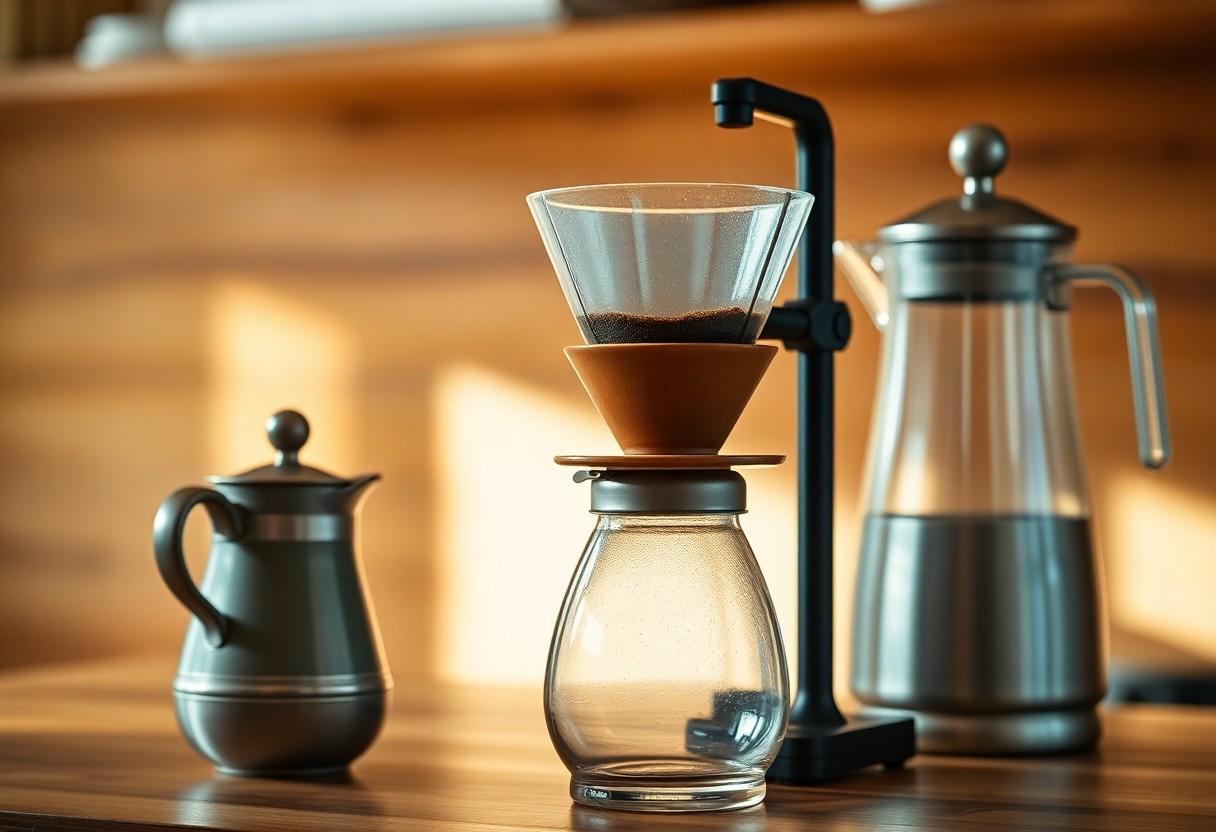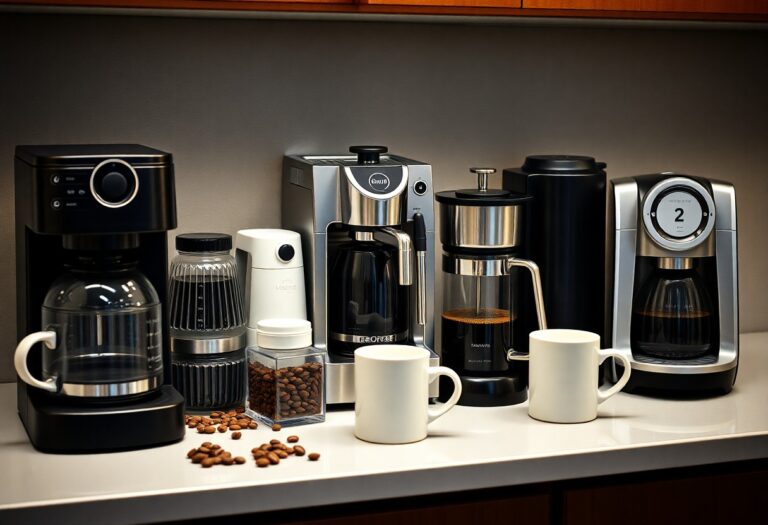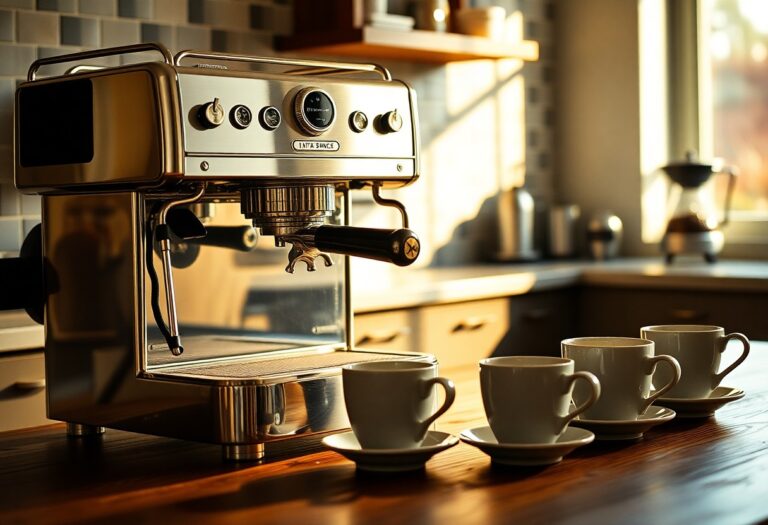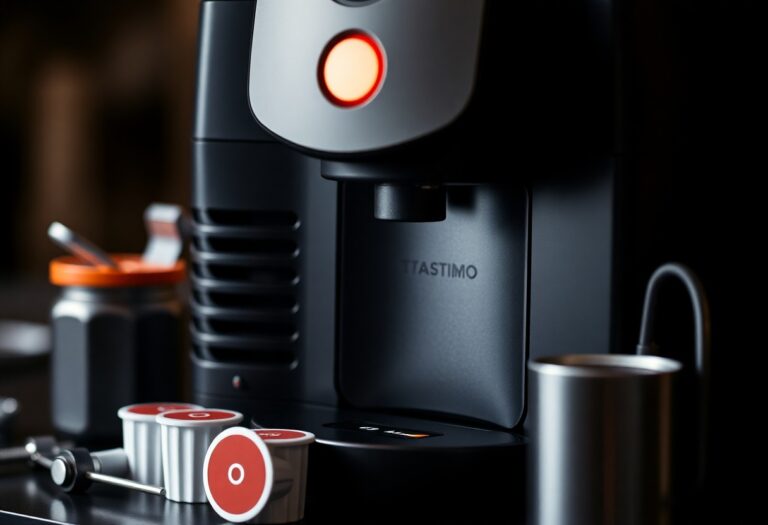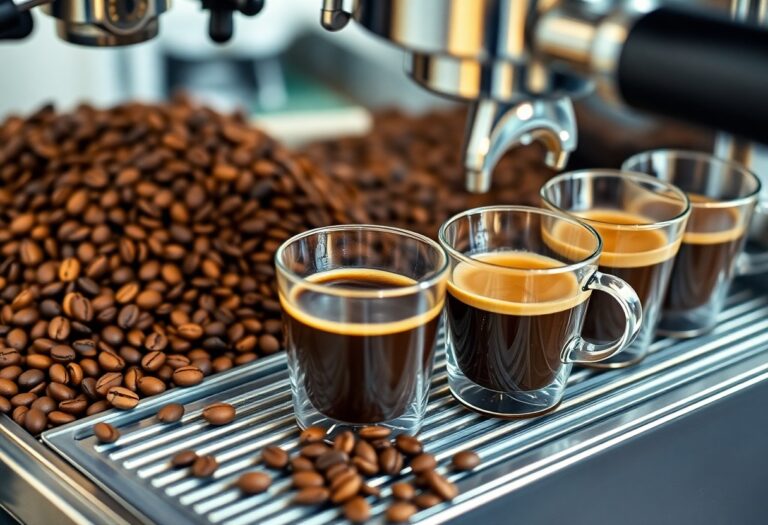What is a Pour Over Coffee Machine – Manual Brewing System
Just when you think you’ve mastered your morning routine, the pour over coffee machine offers you a chance to elevate your coffee experience. This manual brewing system allows you to control every aspect of your brew, from water temperature to pour rate, ensuring that you draw out all the rich flavors of your coffee beans. By using a pour over machine, you engage with your coffee on a deeper level, leading to a more satisfying and flavorful cup each time. Let’s explore into how this method can transform your daily coffee ritual.
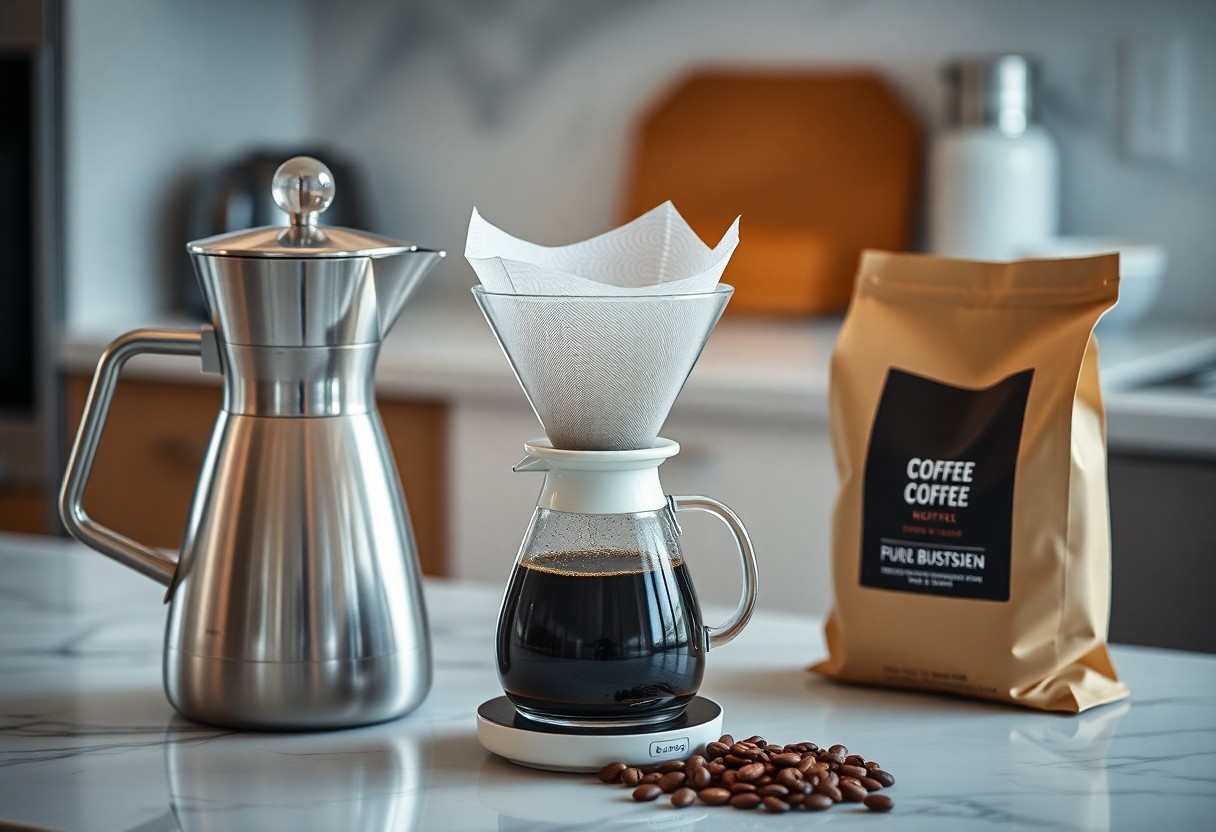
Key Takeaways:
- A pour-over coffee machine offers a manual brewing system that allows for precise control over extraction and flavor development.
- This method emphasizes the importance of water temperature, grind size, and pour technique to enhance the quality of the coffee.
- Pour-over coffee machines come in various designs, including electric and stovetop options, catering to different preferences and experiences.
- Using a pour-over system can lead to a cleaner cup of coffee, as it typically uses filters that trap oils and sediment.
- Engaging with the pour-over process can be an enjoyable ritual for coffee enthusiasts, promoting mindfulness and appreciation for the brewing craft.
The Art of Manual Brewing: Pour Over Defined
Pour over coffee is a manual brewing technique that emphasizes precision and care in the extraction process. This method involves pouring hot water over coffee grounds in a filter, allowing for a deeper appreciation of flavor nuances as you control variables like water temperature, pour speed, and saturation. By engaging with your coffee, you can transform a simple brew into a rich sensory experience. For comprehensive insights and tips, check out this Guide To Pour-Over Coffee.
What Sets Pour Over Apart from Other Brewing Methods
Unlike drip machines or French presses, pour over brewing provides you with full control over the brewing variables. This control allows you to adjust the grind size, water temperature, and pouring technique to highlight specific flavor profiles, resulting in a cup of coffee that is distinctly yours. The hands-on process encourages an intimate connection between you and your brew, elevating the entire experience.
Key Components of a Pour Over Coffee Machine
A pour over coffee machine combines several key components that contribute to its functionality and effectiveness. Typically, you will need a brewing vessel, a filter holder, coffee filters, and a carafe or server to collect your brew. Each component plays a significant role in preserving the integrity of your coffee while offering a platform for precise manual brewing.
The brewing vessel is where you prepare the coffee grounds, while the filter holder ensures optimal water flow during extraction. The choice of coffee filter impacts flavor clarity, as paper filters tend to absorb oils while metal ones allow them to pass through. A carafe collects the brewed coffee and often includes a lid to retain heat. Investing in quality components enhances your brewing experience, making it easier to achieve a consistent and delicious cup every time.
Mastering the Technique: Steps to Perfect Pour Over Coffee
Achieving the perfect pour over coffee requires a blend of technique, timing, and quality ingredients. By refining your skills, you can highlight the unique flavors of your coffee beans, creating a brew that’s rich and satisfying. This section will guide you through the vital equipment, ingredients, and a step-by-step process to elevate your coffee game.
Essential Equipment and Ingredients
Your pour over setup hinges on quality ingredients and the right tools. Essential equipment includes a pour over brewer (such as a Kalita Wave or Hario V60), a gooseneck kettle for precise pouring, coffee filters, and a scale to measure your coffee and water accurately. Freshly roasted coffee beans and filtered water are key to enhancing your brew’s flavor.
Step-by-Step Brewing Process
Following a systematic approach ensures a consistently excellent cup of pour over coffee. Start by measuring your coffee and water, typically a ratio of 1:15. Grind your beans to a medium-coarse consistency; the size directly affects extraction. Place your filter in the brewer, rinse it with hot water, and add the ground coffee. Slowly pour hot water in a circular motion to bloom the coffee before continuing with the rest of the water. Allow the coffee to fully extract, which should take about three to four minutes.
Step-by-Step Brewing Process
| Step | Description |
|---|---|
| 1. Measure | Weigh 20 grams of coffee and 300 grams of water for a 1:15 ratio. |
| 2. Grind | Grind the coffee to a medium-coarse texture. |
| 3. Rinse | Place and rinse your filter with hot water to remove paper residue. |
| 4. Brew | Slowly pour water over the coffee in a circular motion, allowing for 30 seconds of bloom. |
| 5. Extract | Continue pouring until you reach the desired amount—approximately 3-4 minutes total. |
With practice, mastering the pour over process becomes intuitive, allowing for varied adjustments in grind size, water temperature, and pouring technique that can yield different flavor profiles. Pay attention to the brewing time and the water flow rate; even small changes can significantly impact your coffee’s taste. Don’t hesitate to experiment with your origin beans to discover unique flavor notes that emerge from each type.
More on Brewing Techniques
| Tip | Description |
|---|---|
| Water Temperature | Use water heated to between 195°F and 205°F for optimal extraction. |
| Pouring Technique | Adopt a gentle spiral motion to ensure even saturation of the coffee grounds. |
| Brewing Time | A perfect extraction usually takes about 3-4 minutes; adjust based on taste preferences. |
Engaging with these techniques can yield remarkable enhancements to your pour over experience. Crafting your cup with attention boosts your appreciation for the art of coffee brewing and allows you to showcase your knowledge as you share your perfect cup with others.
The Flavor Factors: How Pour Over Influences Taste
The pour over method significantly impacts the flavor profile of your coffee. The process allows you to control variables such as extraction time and water distribution, which affects the acidity, body, and aroma of your brew.
- Extraction Time: Longer times can increase sweetness and body.
- Grind Size: Finer grinds create more surface area, enhancing extraction.
- Water Flow: Controlled pours improve flavor consistency.
- Batch Size: Influences total dissolved solids in your cup.
Any small adjustment can lead to a distinctly different tasting coffee, making the pour over method both an art and a science.
The Science of Extraction: Timing and Technique
Understanding extraction is vital for achieving the desired flavor in your pour over coffee. The balance between timing and technique ensures that you extract the right compounds from the coffee grounds. Pouring water too quickly can cause under-extraction, leading to sour flavors, while a slow pour may result in over-extraction, resulting in bitterness. Precision in your pouring method, whether you swirl, pulse, or steady stream, all contributes to the final taste.
Water Quality and Temperature: The Unsung Heroes
The quality and temperature of your water can profoundly influence your coffee’s flavor. Ideal brewing temperatures range between 195°F and 205°F. Using filtered water enhances taste by removing harmful impurities, while also ensuring optimal extraction of desirable flavors in the coffee grounds.
Water Quality and Temperature Facts
| Water Quality | Temperature Range |
|————————|————————–|
| Filters remove impurities | 195°F to 205°F |
| Avoid distilled water | Flavor influences |
| Municipal water varies | Compounds extraction |
Using fresh, clean water can lift your pour over coffee to new heights. Water contributes up to 98.5% of your final drink, making its role as important as the coffee itself. Opt for filtered water to enhance flavor clarity and ensure that the final cup is a true representation of the beans’ character.
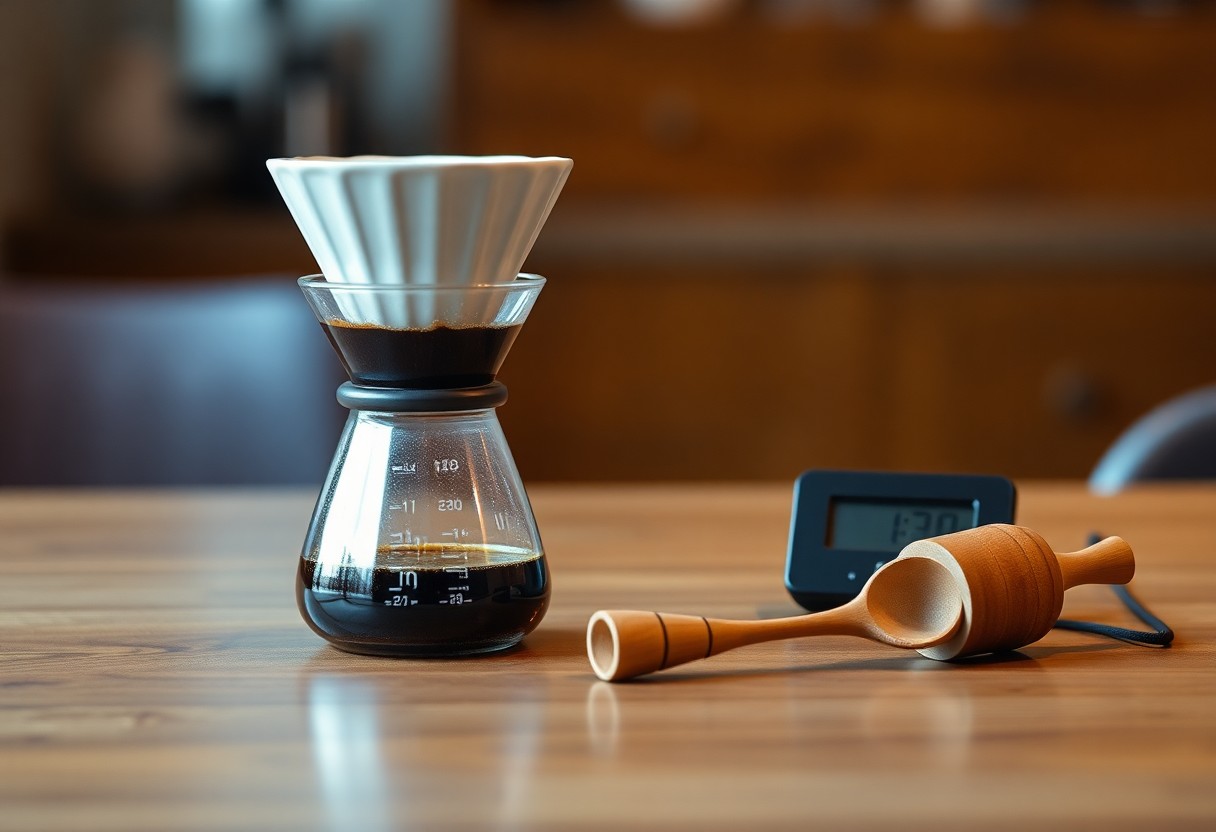
Brewing Rituals: Elevating Your Coffee Experience
Engaging in the pour-over method transforms coffee brewing into a captivating ritual. Each step allows you to immerse yourself in the process—heating water, selecting beans, and watching the liquid dance through the grounds. This not only enhances the flavors but also prompts mindfulness, making each sip a celebration of skill and attention. As you refine your technique and learn to appreciate the nuances, your coffee experience transcends everyday consumption, becoming a cherished personal routine.
The Meditative Aspects of Manual Brewing
Pour-over coffee brewing embodies a meditative practice that encourages you to focus on the present moment. The rhythmic motions, from pouring water to observing the bloom, invite a sense of calm and tranquility. As you engage with the task at hand, the distractions of daily life fade away, allowing for a peaceful, mindful coffee experience.
Personalizing Your Pour Over Routine
Your pour-over routine offers endless possibilities for personalization, from bean selection to water temperature and pour technique. By experimenting with different grind sizes or adjusting your water-to-coffee ratio, you can tailor each brew to your exact taste preferences. This hands-on approach not only enhances the flavor profile but also fosters a deeper connection to the coffee you create.
Delving into personalizing your pour-over routine means exploring different coffee origins, roast levels, and flavor notes. For instance, sourcing beans from Ethiopia may evoke bright acidity and fruity flavors, while a Colombian blend can offer rich, chocolaty undertones. Adjusting the water temperature within the 195°F to 205°F range allows you to extract various flavor complexities—hotter water extracts bold flavors, while cooler temperatures highlight delicate notes. By noting each tweak and its effect on your concoction, you ultimately develop a unique brewing style that reflects your preferences and enhances your overall experience.
Common Challenges and How to Overcome Them
Working with a pour-over coffee machine can present several challenges that, if overlooked, may affect the taste and quality of your brew. From achieving the right extraction levels to resolving technical issues with your equipment, it’s crucial to recognize potential pitfalls and apply simple solutions to enhance your coffee-making experience.
Avoiding Over-Extraction and Under-Extraction
Finding the sweet spot for extraction is key to enjoying a well-balanced cup of coffee. Over-extraction occurs when water interacts with coffee grounds for too long, leading to bitterness, while under-extraction results in a sour taste due to insufficient brewing time. Aim for a water temperature of around 195°F to 205°F and experiment with different grind sizes; a medium-fine grind usually works best to achieve a harmonious balance.
Troubleshooting Common Pour Over Issues
Common pour-over issues often stem from variables like water temperature, grind size, and brewing time. If your brew lacks flavor, consider checking the grind size first; too coarse may lead to a weak cup, while too fine can cause over-extraction. If your coffee tastes uneven, try adjusting your pouring technique, ensuring you evenly saturate the grounds for better extraction. Additionally, keep an eye on the water temperature; water that’s too hot or too cold will significantly alter the flavor.
To tackle uneven extraction or inconsistent flavor profiles, consider tracking your brewing parameters, including the coffee-to-water ratio and total brewing time. For instance, using a scale to measure both the coffee and water can help achieve precise ratios every time. If you encounter a bitter taste, it may be due to a longer brew time or uneven saturation. Adjusting your pouring method—using a circular motion to ensure all grounds are equally saturated—can also mitigate these issues, leading to a more balanced and enjoyable cup.
Conclusion
To wrap up, a Pour Over Coffee Machine offers you a hands-on method to brew coffee, allowing you to control each step for a personalized flavor profile. This manual brewing system emphasizes precision and patience, ultimately enhancing your coffee experience. For a detailed guide on getting the best out of your pour-over setup, check out How to Use a Pour Over Coffee Maker. Your morning ritual will never be the same!
FAQ
Q: What is a pour over coffee machine?
A: A pour over coffee machine is a manual brewing system that allows coffee enthusiasts to control the brewing process by pouring hot water over coffee grounds placed in a filter. This method emphasizes the extraction of flavors and aromas, producing a clean and flavorful cup of coffee. The pour over technique allows for precision in water temperature and flow rate, enhancing the overall brewing experience.
Q: How does a pour over coffee machine work?
A: The pour over coffee machine operates by utilizing a cone-shaped dripper that holds the coffee grounds and filter. Users start by heating water to the desired temperature. After adding coffee grounds into the filter, they slowly pour hot water over the grounds in a circular motion, allowing the coffee to brew as the water seeps through, extracting flavors and oils before dripping into a carafe or cup below. The control over the pouring technique is what distinguishes this method from automatic machines.
Q: What are the advantages of using a pour over coffee machine?
A: Using a pour over coffee machine offers several benefits, including enhanced control over brewing variables such as grind size, water temperature, and pouring technique. This method allows for precise extraction of flavors, resulting in a more personalized cup of coffee. Additionally, the simplicity of the equipment makes it easy to clean and maintain. For coffee enthusiasts, pour over brewing provides a tactile and engaging experience that enhances their appreciation for the coffee-making process.
Q: Can I use any type of coffee with a pour over coffee machine?
A: While you can technically use any type of coffee with a pour over coffee machine, the best results come from using freshly roasted, high-quality coffee beans. The grind size is also important; a medium to medium-coarse grind is typically recommended. Different beans and roast profiles can yield varying flavors, so experimenting with various types will allow you to discover your preferences and achieve the best possible cup.
Q: How do I clean and maintain my pour over coffee machine?
A: Cleaning a pour over coffee machine is relatively simple. After each use, remove the spent coffee grounds and dispose of them properly. Rinse the dripper and filter holder under hot water to remove any residual oils and coffee. For a more thorough cleaning, you can wash them with mild soap and water. Make sure to rinse well to avoid any soap residue. Regularly checking for any buildup and ensuring all components are dry after cleaning will help extend the life of your pour over coffee machine.

